Note: This post contains Amazon Affiliates links, which means that if you buy something through these links, I might get a small commission, at no extra cost to you.
Riviera Maya, with its world renowned all inclusive resorts, is a traveler’s paradise. From stunning, sandy beaches, surrounded by crystal clear waters to Mayan ruins and amusement parks, from cenotes and lagoons to swimming with turtles, Riviera Maya is one of those place that will stay in your memory forever. It is, perhaps, our favorite place in the world and after traveling there 5 times, we still feel like we haven’t covered even half of the things that the Mayan Riviera has to offer.
In this article, I am not going to talk about the famous themed parks (Xcaret, Xenses, Xplor etc) or the famous Mayan ruins (Tulum, Coba, Chichen Itza). I will assume that most people know about them, because they are so famous. Instead, I will give you some ideas of amazing things to do that most people don’t know about. This is my list of must do activities in Riviera Maya.
Table of content
1. Tour the Sian Ka’an biosphere reserve

People don’t talk enough about this place. Period. Touring Sian Ka’an is hands down one of our favorite activities of all times.
*Note: we did this tour before we had kids. The minimum age I recommend for it is 3, or after the kids drop their nap. The tour takes 4-6 hrs.
Located about 90 min away from Tulum, the bioreserve boasts rich flora and fauna, tropical forest, mangroves and marshes. You might see crocodiles, dugongs, dolphins, fish, manatees, sea turtles and many species of birds.
There is also a Mayan ruin on site called Muyil.
Our favorite part of the tour was floating down the canal, which was like a natural lazy river. The salt water from the sea, mixed in with the freshwater from land, creates a current that moves you along. We floated through mangroves for about an hour. I can’t put into words how amazingly peaceful this activity was!
We learned that the canals were build by the Mayan people more than 1200 years ago, to connect Tulum to Muyil. They are very narrow, so only a boat can fit through. The limestone filters the water, so it’s crystal clear and you can see all around you.
You can go to Sian Ka’an on your own, but I highly recommend that you hire a guide or pay for a tour. You definitely don’t want to drive your rental car down the road that takes you to Muyil, as there are a lot of potholes.
We toured the bioreserve with Community Tours Sian Ka’an. We chose them because they are a non-profit organization dedicated to protecting the reserve. All of the profits they make go into the Mayan community and they employ primarily Mayans. They strive to improve the life of locals by creating jobs and selling products manufactured in the community. If you want your money to make a difference, Community Tours is the place to invest into!!
Community tours picked us up at our hotel in Tulum and drove us down to Muyil. We started by visiting the ruins, then did the canal float. When we were done with that, we were taken by boat through the most pristine lagoon to get back. At the end of the tour, we received a meal that consisted of fish and rice, cooked following a Mayan recipe that was hundreds of years old. We still talk about how delicious that fish was.
If you want to book a tour with Community Tours, you can click here. To see their Facebook page, click here.
2. snorkel at Yal’Ku lagoon
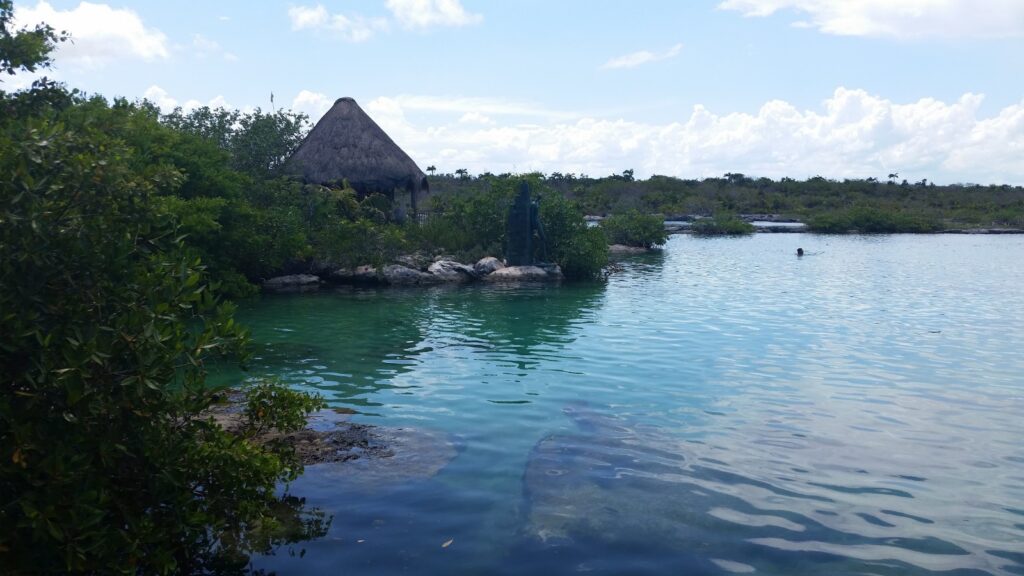
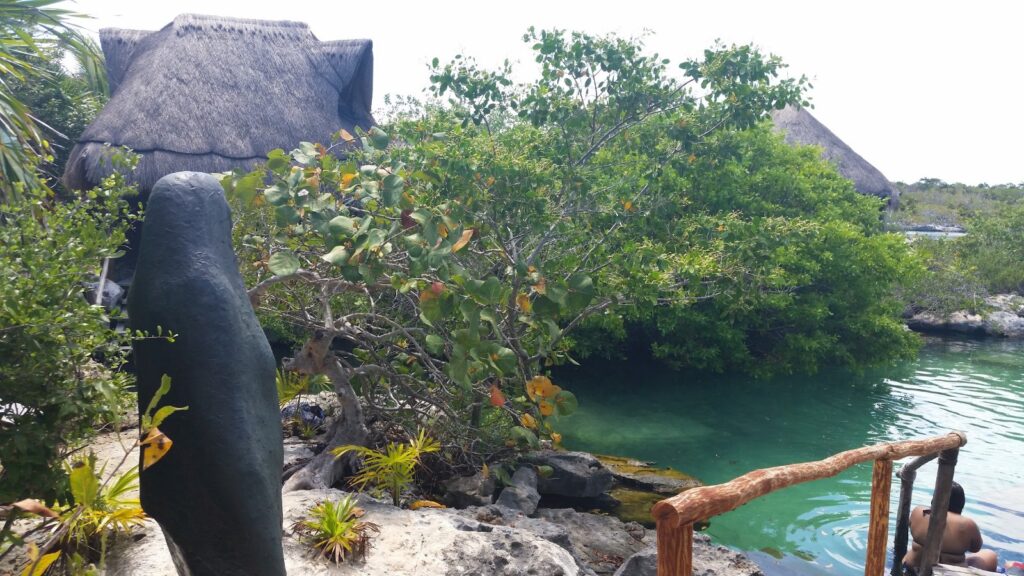
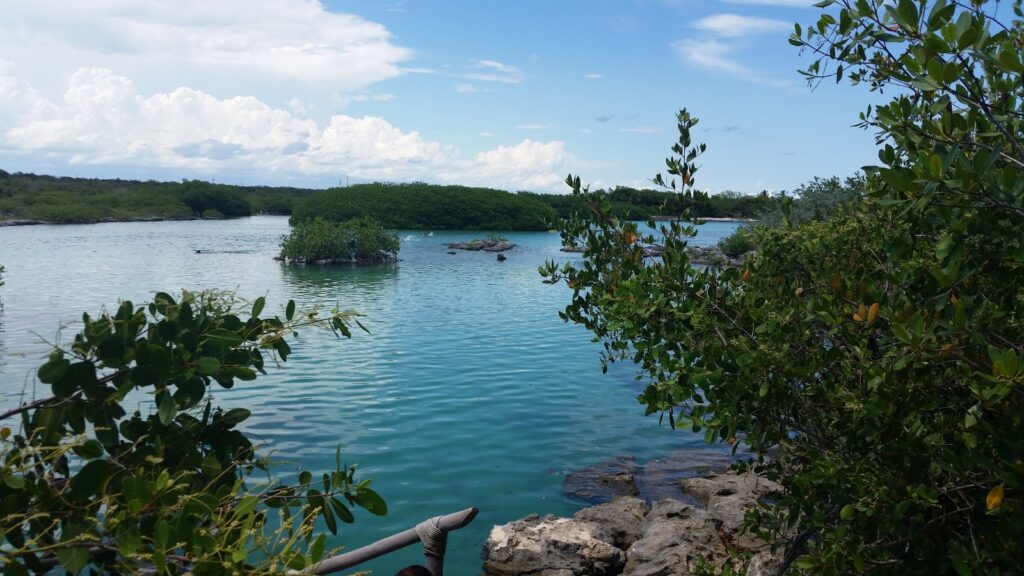
You guys, is there a place that you have visited a lot of times and feel like you could never get enough of it? That is Yal’Ku Lagoon for me. It is always at the top of the must do activities in the Riviera Maya for me and I always recommend it to people.
We have been there 4 times and I can’t wait to go back this year with our kids. Last time we went, Tavi was 21 months old and Roby was 3 months. Tavi snorkeled with us, but Roby was too young.
For Tavi, we used this clear bottom inflatable raft and he was able to lay facing down and look at the fish. We also had this underwater viewing bucket that fit into this snorkeling float, so he wouldn’t have to put his head under water.
The water in this lagoon is very clear and calm. You can see tons of marine life, from exotic fish, to octopi, sea turtles and sting rays. Life jackets are mandatory and you can rent them there. I strongly advise you to wear a full body swim suit while you snorkel, as the sun is very bright and you will be facing down the whole time. We got sun burned pretty badly on our first trip there. I now own this wetsuit jacket that I put on every time I snorkel. For my kids, I got this cute shark bathing suit. Not only that they are protected from the sun, but they look adorable!
Also, keep in mind that you are only allowed to apply biodegradable or coral reef friendly sunscreen.
Yal’Ku Lagoon is located in Akumal. You don’t need to hire a guide to visit the Lagoon. You pay entrance when you get there and you can also rent snorkeling equipment. Daily tickets are 200 pesos for kis (around $10) and 280 pesos for adults (around $14). Plan to arrive as early as possible in the day, to avoid the burning sun and possible crowds.
3. swim with turtles in Akumal
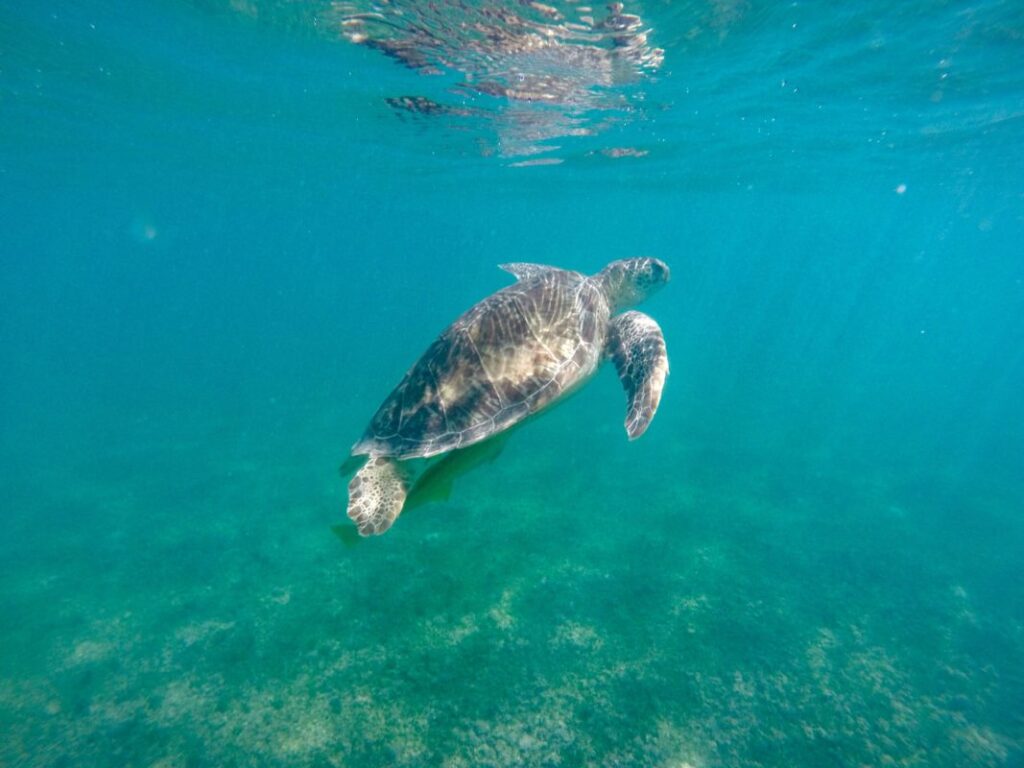
Akumal is the place if you want to see turtles in their natural environment. When we first went to Akumal beach in 2015, you could go out on your own to snorkel and find the turtles. When we returned a few years later, we found out that the rules had changed and you can only do it with a tour now. We were told that people had a hard time respecting boundaries and giving turtles space.
You can still go out on your own for about 150 feet, but you are not guaranteed to see turtles in that area. For families with young kids, I advise to join a tour. They know exactly what they are doing and where to take you.
You will find a bunch of self proclaimed ”licensed” guides on the beach, offering to give your tours. The ongoing rate when we went was about $50/ family of four.
Swimming with turtles is one of the most magical experiences! We must have spent a good half an hour just looking at them go down to get a mouthful of seagrass, then heading back up to the surface for air. We also saw a bunch of other fish and sea creatures.
Try to get to Akumal as early as possible. You want the best water visibility and that is before the big crowds arrive. When you get to Akumal, you will be approached by a lot of people offering you parking and tours. For parking, go past the two lots on your right and keep going until you see the parking lot on your left (you can’t miss it, as it has some big, metal gates). This lot had shaded spots and if you arrive early enough, you might get one. Parking is around 50 pesos ($3) everywhere.
After parking, you will be approached by guides wanting you to hire them for the tours. This is my least favorite part, as I do not enjoy haggling at all. Try to talk to a few different people and see if any offer better prices. Sometimes they will drop the price if they see you walking away.
Another option is to hire a tour online, if you don’t want to deal with all the details of driving to Akumal, parking, finding a guide etc. You will, obviously, pay a lot more, but if convenience ranks high on your list, then it’s worth it.
4. Casa cenote, Tulum
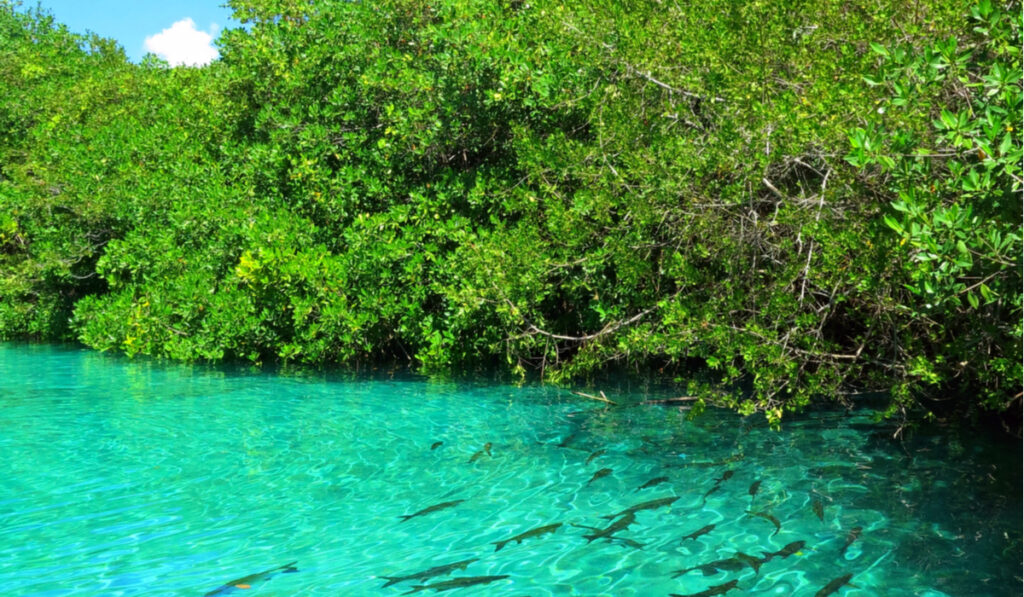
The Yucatan peninsula is home to over 6000 cenotes! This can make it hard to decide which one to visit. I always advice people to go to at least a couple of them: one in a cave and one in an open rock formation. The cave cenotes are the most famous ones, but we found a beautiful, open cenote in Tulum that stole our heart.
Unlike most cenotes, which are covered or partly covered, Casa Cenote is open, so the water is warm, making it perfect for families with kids.
This cenote is connected underground to the ocean, so divers can make their way into the sea. Also, because it has both fresh and seawater, Casa Cenote has both fresh and seawater fish. You won’t find that in a cave cenote.
The cenote is open from 9 am – 5 pm and you can rent snorkeling gear there. The entrance is 150 person/person (around $7) and the life jacket is included. Make sure you bring cash, so you don’t have to pay credit card fees.
Getting to the cenote can be a bit confusing, as there is also a house called Casa Cenote right across the street. If you set your GPS for Casa Cenote, you will most likely be taken to the house. The cenote is across the street
*Note: while this was not our experience when we went in 2015, there are a lot of negative reviews now from visitors who complain about the people who run the admission/equipment rental booth. Their main complaint is that they felt ripped off when asked to pay to use their own go pro cameras. Also, nowadays you need to hire a guide to go past a certain area in the cenote.
In spite of this, we will go back to this cenote next time we visit Riviera Maya. The reason is that I believe it’s worth the price. I love the mangroves around it, the water is crystal clear and there is even a ”house” crocodile, who is apparently very gentle and has never bothered anyone. Casa Cenote offers a unique experience and I am willing to get over the annoyance of dealing with people and pay extra for something that we will fondly remember for the rest of our lives.
5. Cenote Sac Actun
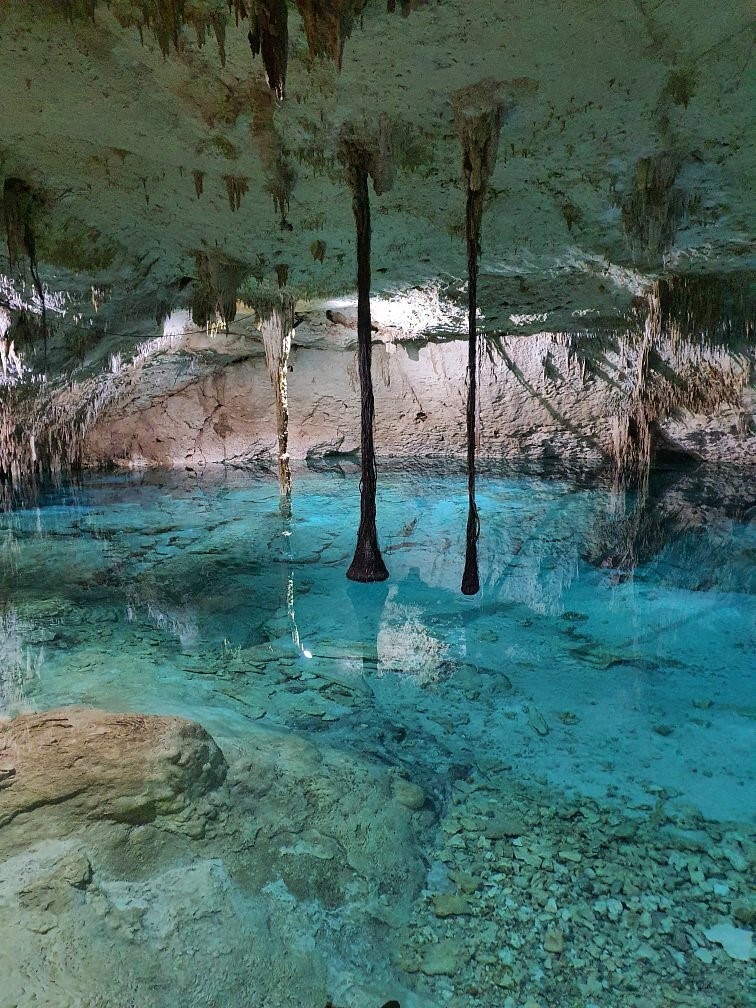
I think that we can all agree that all the cenotes in the Yucatan peninsula are amazing, and visiting each and every one of them would be worth it, if you had enough time. But since most of us don’t live there, we have to narrow our list down to just a few of them.
Cenote Sac Actun is one that you should not miss. What makes it so unique? Well, Sac Actun is, in reality, a underground cave system that measures over 347 km (approx. 215 miles). In 2018, they discovered a connection between Cenote Sac Actun and Cenote Dos Ojos, making this the longest underwater cave system in the world!!
What makes it even better? The fact that Dos Ojos is the more famous one and therefore most of the crowds go there, leaving you to have a peaceful experience in Sac Actun.
And thirdly, another reason to visit Sac Actun is because they have discovered calcified bones of mammoths, giant sloths, bears and another sacrificial animals there, dating more than 12 000 years ago!!! A detailed shrine to the Mayan god of war and commerce was found in the cave system too, together with burned human bones and ceramics. This has given Sac Actun the popular name of “Pet Cemetery”.
And while you are unlikely to see any bones or remains on your tours, Sac Actun is worth a visit for its beauty alone. Stalagmites, stalactites and rock formations beautifully decorate this cenote.
Some things that you should know before visiting Sac Actun:
1. The best way to get to it is by driving or taking a taxi
2. You are not allowed to go in without a guide. Not only that you can get lost easily in the cave system, but the guides are there to protect the precious stalagmites and stalagtites.
3. You can rent snorkeling equipment and full body swim suit there. You really should not cheap out on the wetsuites, as the water is very cold. You can also bring your own. I bought this full body wet suit for my kids and it works perfectly. I got myself this wetsuit jacket and these capri pants, but I find myself snorkeling a lot with just the jacket and not using the pants a whole lot. If you think you get cold easily, you should probably get both.
4. The fee for entrance, snorkeling equipment, life jacket and wet suit is 450 pesos (around $20).
packing list
These are the essential things to pack for a trip to Riviera Maya:
1. Snorkeling equipment – while most places have their own equipment that you can rent, I’ve learned in time that they are not the best quality. Plus, a lot of people touch them and put them on their faces and that just grosses me out. So we purchased our own snorkeling equipment in 2015, when we first went to Tulum. We’ve been carrying around with us when we travel, and while that is a bit inconvenient, it’s worth it.
2. Snorkel for the kids – this is the best we’ve found so far.
3. Goggles – we love this brand. Not only that it protects our eyes from saltwater/chlorine, but because they are polarized, they also offer sun protection
4. Clear bottom inflatable raft for little kids, so they can snorkel with you – we bought this for Tavi and he was able to join us snorkeling when he was 21 months.
5. Towels – I think I have a little obsession with these towels. I mean, when I take the kids to the pool now, I only bring one towel for the three of us! Goodbye soggy towels!
6. Biodegradable sunscreen – we like this one that comes in a package of two.
EXtra tips
1. Rent a car if you are comfortable driving in a different country. You will have a lot more freedom and flexibility to explore on your own.
2. Renting a car in Mexico is cheap. What’s expensive is the insurance. There are three different types of insurance in Mexico: third-party liability (also called basic personal liability), supplemental liability insurance and loss damage waiver (or collision damage waiver). Only the first one is mandatory and it is usually included with the rental, so don’t let yourself be fooled into buying extra insurance, unless you think it’s necessary.
3. Get cash (preferably pesos) as soon as you get to your destinations. That way, you avoid paying extra credit card fees.
